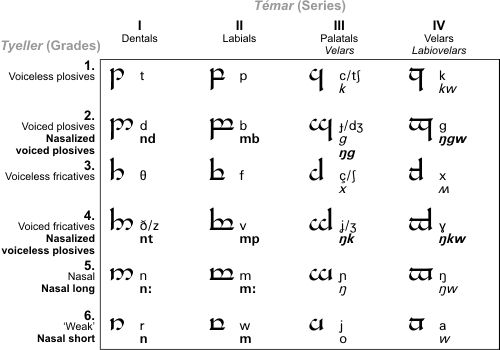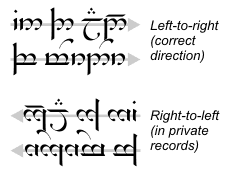Feanor became interested in languages and writing systems early in his career, and he invented the Tengwar writing system in the Valian Year 1250 [AAm]. The Tengwar was strongly influenced by Rúmil’s Sarati (until then the only existing writing system), but just as Rúmil has incorporated the contemporary philological ideas in his creation, so Feanor devised his writing system according to his own theories. The greatest difference between the two systems was that while the Sarati contained letters of quite varied appearance, the Feanorian letters for the most part consisted of a very limited number of building-blocks that could be combined to form a system of consistent and interrelated letters. Also, while the Sarati allowed several different writing-directions, the only correct writing direction of the Tengwar was in horizontal lines running from left to right.
The symbols of the Tengwar can be divided into letters — tengwar proper — and diacritic marks — tehtar. These are discussed in turn below.

The two basic elements of all the primary tengwar were a telco, “stem”, and a lúva, “bow”, which could be combined and modified in a number of different ways. A telco could be hanging (the “default” state), shortened, raised, or extended. A lúva could be placed either to the left or the right of a telco. It could be either open, or closed by a horizontal line. In addition, a lúva could be doubled. In this way, from a limited number of possible alterations, a system consisting of thirty-two tengwar was devised.

Note on plurals in -r: In Quenya, which is the language for most of the terms involved when describing the Tengwar, nouns generally form plurals by adding -r or -i. Thus, one tengwa, tehta, telco, lúva, téma, tyelle — many tengwar, tehtar, telcor, lúvar, témar, tyeller.
It was then decided that tengwar whose telcor and lúvar were organized a particular way represented a certain group of related sounds: the telcor determined how the sound was articulated, and the lúvar where in the mouth it was made. Exactly what sound values were assigned to which tengwar could be adjusted to the needs of a particular language. These different adjustments were called modes [AppE].
By the end of the Third Age it had become the custom to display the primary tengwar sorted by appearance in a table with four columns (in Quenya: témar, “series”) and six rows (tyeller, “grades”). In such a table each téma would correspond to one point of articulation, and each tyelle to a method of articulation. This is readily seen in figure 1, where the sound values of each tengwa in some common modes are given according to the International Phonetic Alphabet. The two grades of tengwar with extended stems were usually not included, since they were regarded as variant forms of the tengwar with raised stems (grade 3 and 4).
Figure 1: Table of the Primary letters.
The technical phonetic terms given in the left and top margin correspond to the
phonetic values written in the same style in the table. Thus, since
ŋk
in series III, grade 4 is written in bold italic, the sound is a velar (italic)
nasalized voiceless plosive (bold).

In all modes, each tengwa was given a name in which its sound value occurred as early as possible. But when one, unambigous name for each tengwa was needed, the Quenya names were used. Since the tengwar of the first grade in Quenya had the sounds t, p, c, qu, their names were tinco, parma, calma, quesse. Consequently, the four series were universally known as tincotéma, parmatéma, calmatéma, and quessetéma. For a thorough description of the letter-names, see the article Tengwar Names.
Beside the primary letters, there existed a large number of irregular, additional letters which were not based on a telco and a lúva. Of these, twelve common ones were regularly included in the tabular arrangement of the Third Age, though their sound values did not fit the phonetic system of the four series. These additional letters are given in figure 2.
Figure 2: Table of the Additional letters.

Most of the additional letters were actually modified forms of primary letters. Of the ones in the table, the letters for s and l were the only totally independent letters. The following derivations are either stated by Tolkien, or are very probable educated guesses; the latter are shown in grey.


Tehtar are marks of varying appearance that are placed around the tengwar to modify their pronunciation. A common tehta has the shape of a horizontal line placed below the lúvar. It is frequently used to indicate that a consonant is long or double. The same tehta placed above is often used to indicate that the tengwa is preceded by a nasal of the same series (see figure 1). Another tehta has the shape of a curl or swash that is attached to the tengwa, usually at the bottom-right end of the rightmost lúva. This tehta indicates that the consonant is followed by an s.
Contrary to the beliefs of Rúmil and his contemporaries, Feanor thought that the vowels had a phoneme value equal in importance to that of the consonants. The vowels were in the Tengwar, as in the Sarati, still usually represented by diacritic marks, called ómatehtar or “vowel-marks”. This was solely for the sake of compactness, though, and Feanor also constructed a mode for Quenya where each vowel was assigned to a tengwa. This mode was primarily intended for the “loremasters”, and was rarely used; if any samples of the mode have been preserved they have not been published, and we do not know how it looked like. It is said to have been the origin of such modes as the Sindarin mode of Beleriand [FQD].
Figure 3 lists a selection of frequent vowel-marks. The sound values given are by no means the only ones used. The ómatehtar were usually placed above the preceding or the following consonant tengwa, depending on writing convention. In some samples, the vowel-marks are allowed below the tengwar as well. They are then always turned upside down.

When no tengwa is available in the required position, a carrier is often used to carry the vowel-tehta. This is derived directly from the vowel-carrier of the Sarati. Many modes distinguish a long carrier, which can be used when the vowel in question is long.
In many modes the tengwar are regarded as if having an “inherent vowel”, a vowel sound (usually a) that is pronounced after its consonantal value. In such modes that vowel does not have to be written out. Instead, consonants that are not followed by a vowel are marked with a tehta (often an underposed dot).
The “inherent vowel” principle may in part explain why the tengwar in the last series of grade 6 are often used for vowels (see figure 1). The “weak” consonant values that these tengwar originally represented had ceased to be pronounced in the concerned languages, leaving behind their vocalic value without any preceding consonantal value. A similar development gave rise to the use of matres lectionis, full letters representing vowels, in the Hebrew alphabet.

In virtually all sources, the Tengwar is written left-to-right in horizontal lines ordered top-to-bottom. This was the “correct” way of writing with the script, as Feanor had designed it: the letter-shapes were designed for easy writing with the right hand. But the ambidexterous Elves could write equally well with either hand. In letters and private records, the Elves sometimes wrote right-to-left instead. When so doing, they would use the left hand, and they would mirror the letters so as to always have the same side turned in the writing direction, as was the case with the Sarati. [EHFN]
Punctuation marks that represent a pause in the text (like the period, comma or semicolon in the Roman alphabet) are usually based on various arrangements of dots; the more dots, the stronger the pause. A single dot at mid-height · corresponds more or less to the comma. Two dots : is similar to a semi-colon or period. Stronger pauses, e.g. clause endings, can be indicated by three :· or four :: dots. The end of a text is sometimes indicated by two dots followed by a single or double wavy line.
In many English texts, Tolkien has used the standard puncuation marks of the Roman alphabet: period < . >, comma < , >, semicolon < ; >, colon < : >, exclamation mark < ! >, question mark < ? >, and quotation marks < ‘ ’ > < “ ” >.
Read more in Tengwar Punctuation.
The various Tengwar modes are listed in the Tengwar Modes section of this site. Others are described in various locations on the Internet; see the Links section for a good selection of these.